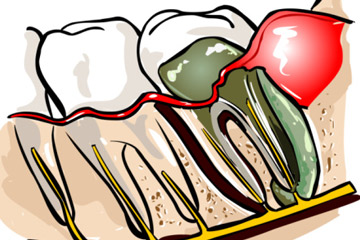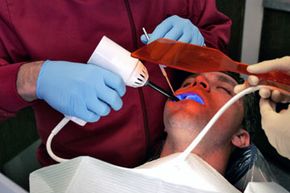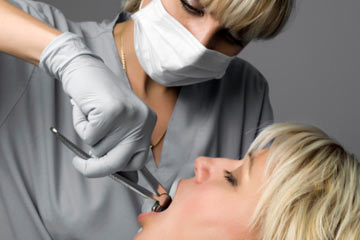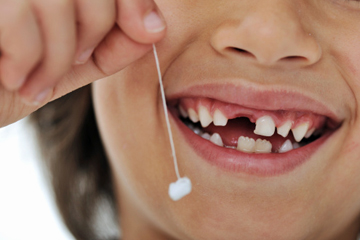
An abscess is one of the worst things you can have in your mouth, and the human body knows it. Let’s just get the graphic details out of the way first: A tooth abscess is a sac-load of thick, yellowish-greenish-whitish pus, and the pus is loaded with bacteria. Our bodies know the bacteria are there, so a natural defense is to create a casing — the sac — to keep the bacteria from spreading throughout the body.
Often an abscess forms inside of a tooth and into the root canals, and other times it fills and grows in the gum area at the base of teeth. Whether it forms inside or outside of a tooth, it will almost always hurt — a lot — from the constant pressure of the swelling and it will need to be drained and cleaned. Sometimes, openings through the teeth or through small breaks in the mouth tissues in the area around an abscess will develop where some pus will leak out on its own, but this slow-drain site — called a fistula — is not enough to rid the mouth and body of the infection [sources: ADA; Alan; CUCDM].
Rupturing an abscess all at once is an effective way to clear out the bulk of the gunk inside, but that’s only the first step in getting rid of it. Ideally, an abscess should be incised by a dental professional, but sometimes the abscess will rupture spontaneously. When a tire on an automobile is over-inflated, something that normally it could just roll over, such as a small, sharp rock, may cause it to blow when stretched beyond its capacity. A mouth abscess is similar, and a particle of food that would normally be broken down in the mouth will poke the abscess and cause it to puncture, sending infected pus throughout the mouth. Or, the swelling may just cause it to rupture on its own.
But when ruptured in a controlled environment with a dentist, an endodontist (root specialist) or other professional, pain relievers and infection control agents can help contain and inhibit the spread of bacteria. And it will be more comfortable than having an unexpected and startling explosion in your mouth.
After reading about what an abscess is, you probably want to know how to avoid getting one in the first place. An abscess often is the result of poor dental hygiene, but it also can result after trauma to a tooth or teeth. Cracks in the enamel provide openings where bacteria can gather insidiously within the broken tooth, or in the pulp inside the tooth. Most of the time, though, you will feel the pain as the infection swells. Not so swell, at all.
So how can you know when a pain in your mouth may be an abscess, and do you have to see a dentist to take care if it? We’ll look at the root causes and telltale symptoms, next.
Contents
- Tooth Abscess Causes and Symptoms
- Antibiotics for an Abscessed Tooth
- Home Remedies for an Abscessed Tooth
Tooth Abscess Causes and Symptoms
Infections happen when bacteria multiply and spread toxins or chemicals through the body or part of the body. That pus we talked about earlier is made up of lots of living and multiplying bacteria, decomposed tissue and a rush of blood. The blood part is likely filled with white blood cells, or leukocytes, that the body sends to the site of an infection to fight it. When an infection is present in the body, one of the first signs is redness and inflammation, showing that blood has rushed to the scene of the germ or bacterial onslaught to stand up to it and keep it contained. This swelling brought on by the activity of the white blood cells helps get rid of the bacteria, but it also causes pain by stretching tissues, adding pressure to the site and adding a throbbing sensation [source: NIH].
With a tooth abscess, sometimes the pulp inside a tooth has already died due to the bacterial infection and the pain has stopped, and then an abscess forms. So, although pain is an indicator in most cases, an abscess may form without any pain until it has advanced for some time. Painful or not, signs of an abscess and related infection can include:
- a throbbing toothache or gum pain that won’t go away
- darting pains when biting down or chewing
- unexpected and random shooting tooth pains
- hot and cold tooth or root sensitivity
- swollen, sore and/or red gums
- persistent bad breath
- feeling of fluid leaking into the mouth that gives you a bad taste or very offensive breath smell, particularly around certain teeth
- tender or swollen glands around the neck and jaw
- oozing sores on the gums
- cheek or facial puffiness or swelling
- fever and a general feeling of being under the weather or sick [sources: Alan; Mayo Clinic; NIH]
Because an abscess is often an infection in the middle of a tooth, there aren’t always visible signs, but there will likely be taste, smell and sensitivity issues that warrant a trip to the dentist. A dentist or endodontist will examine by tapping teeth and probing gums and by looking for hot spots of pain, pressure or leakage. X-rays may help to assess any damage to bones or surrounding gum tissues. An injury to the mouth and teeth is one obvious reason to check for an abscess that may have formed through cracked enamel, but other indicators are built up tartar around the roots of teeth, gum disease, and broken fillings, crowns or other dental work. All of these are signs that oral hygiene may not be up to par or has suffered. Sometimes, however, the cause can even be a trapped particle of food between teeth and gums [sources: Alan; NIH].
Signs of serious infection include sharp, deep pain and facial swelling and you should get to a dentist right away — or to an emergency room if after office hours. Abscess infections can spread throughout the bloodstream and body quickly, leading to sickness and even death if untreated [sources: Alan; Mayo Clinic].
Death by toothache? No, but the associated infections can make you sick, or worse. Most often, however, you can fight them long before they spread throughout the body. How? We’ll take a look, next.
Antibiotics for an Abscessed Tooth
“
iStockphoto/Thinkstock
One dreaded phrase associated with a tooth abscess is "root canal," and in cases of extreme infections or bone loss, a tooth may even need to be extracted in order to get rid of the abscess and repair the infection site damage. Getting inside a tooth to check the extent of damage and to remove infected pulp is a procedure called a root canal and it’s also the name of the canal deep within the tooth. An abscess can be drained, carved out and cleaned, and then sealed and capped to prevent any further damage or pain [sources: AAE; ADA]. Root canals are fairly common for an abscess within the tooth — called a periapical abscess — and the prognosis for recovery is good.
In the case of a periodontal abscess, the kind between the teeth and gums, the abscess is purged and the area is well cleaned, but an additional step finishes the treatment. Although the abscess sac and its pus content are dealt with, the bacteria need to be killed, too. Often, this bacteria has spread to the surrounding gums and deep between teeth and a dentist or endodontist will apply and prescribe antibiotic treatment. Antibiotics kill off the infectious bacteria at the site and prevent it from spreading through the bloodstream. A periapical abscess may be treated with antibiotics, as well [source: CUCDM].
If an abscess is only drained and not treated, the pain and soreness in the mouth might ease up, but complications from the bacteria itself can cause jaw cysts and infections, pneumonia, sepsis, heart complications, or a brain abscess among other serious and even life-threatening conditions. Individuals with immune deficiency disorders are even more at risk. As with any medical condition involving antibiotic treatment, it’s very important to finish the entire prescription and any in-office cleaning and antibacterial care even after symptoms are gone [source: NIH].
Are there any instances where an abscess is minor enough to treat at home? Won’t it eventually just rupture on its own and go away? In a word, no. You can get the abscess out of the mouth, but you cannot get the infection out of the body without treatment. Home prevention and pain relief, however, can help. We’ll talk about those next.
Home Remedies for an Abscessed Tooth
Practicing good oral hygiene will help prevent abscesses. Tooth decay breaks down enamel and leads to access for an abscess — through the cavities and decay. Gum disease leads to larger pockets between teeth and gums where food and bacteria can gather. Diets high in sugar and lacking in nutrients increase the likelihood that mouth problems could lead to an abscess. Teeth damaged by force or trauma are also ideal entryways for bacteria. Soon after any accident involving a broken tooth or cracked dental work, have a dentist inspect for fissures of areas where the pulp may be exposed [source: Mayo Clinic].
If you do find yourself with a sudden throbbing, aching, sore and sensitive tooth, make an appointment with a dentist as soon as possible. Rinsing with salt water and using over-the-counter pain relievers or anti-inflammatories can relieve pain in the short term and reduce symptoms, and even help drain some of the pus buildup before it’s purged by a dentist [sources: CUCDM; NIH]. But resist the urge to flush out the infected area yourself! Even if the abscess erupts on its own and pain eases up and you don’t see any symptoms, remember that bacterial infections may be spreading quietly and painlessly inside your tooth or even deeper in the jaw bones.
In most cases a tooth abscess is treatable and teeth can be saved for good, as long as the infection is rooted out. Keeping teeth clean, gums healthy, and cavities or tooth injuries sealed will prevent most abscess infections. Brushing with fluoride toothpaste, flossing and making regular dental checkups are effective preventatives. Following through with antibiotics if an abscess does form will keep bacteria from having access to the rest of your body.





